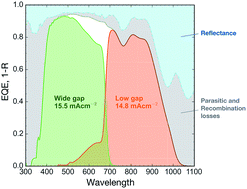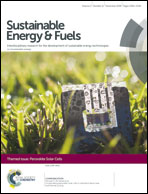Tin–lead halide perovskites with improved thermal and air stability for efficient all-perovskite tandem solar cells†
Abstract
We report the fabrication of monolithic all-perovskite tandem solar cells with a stabilized power conversion efficiency of 19.1% and demonstrate improved thermal, atmospheric, and operational stability of the tin–lead perovskite (FA0.75Cs0.25Sn0.5Pb0.5I3) used as the low gap absorber. To achieve a high matched current density in the two-terminal tandem, we develop a route to fabricate uniform and thick tin–lead perovskites that enable the two-terminal tandem to attain external quantum efficiencies >80% in the near infrared. By post-processing the as-deposited tin–lead perovskite films with methylammonium chloride vapor, we increase grain sizes to over a micron and boost solar cell open circuit voltage and fill factor. Tin–lead perovskite solar cells made by this method exhibit the most stable operation at maximum power under simulated sunlight of any reported small bandgap perovskite solar cell to date. We show that an unencapsulated tin–lead perovskite solar cell maintains its full performance after 150 hours at 85C in air, which is substantially better than has been observed previously. This work identifies strategies for attaining highly efficient all-perovskite tandem solar cells while maintaining thermal and operational stability.

- This article is part of the themed collection: Perovskite solar cells


 Please wait while we load your content...
Please wait while we load your content...
